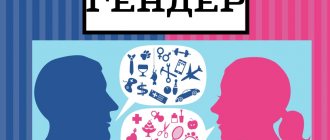“Oh, that’s it”, “Everything is fine with me”, “I’m not talking to you”, “Oh, I didn’t know that this was so important, otherwise I would have done it” - we are all familiar with such phrases, these and similar remarks we We have repeatedly heard it addressed to ourselves or said it ourselves. They are not at all so neutral - in fact, hidden aggression is masked behind them.
Aggression is a universal feature of the human psyche and perception. It can be either active—in open conflict, when we defend our borders or attack the borders of others—or passive. With passive aggression, a person, on the contrary, avoids direct conflict and expresses his anger in a different way.
Passive aggression is not a separate diagnosis or a symptom of a mental disorder or illness, but a form of behavior. Any healthy person experiences anger, anger and aggression. But some people go into open confrontation, while others suppress emotions and try to come to an agreement with themselves. Some due to the fact that they do not feel the weight in a quarrel, and some because they do not know how to defend personal boundaries - it is people with violated personal boundaries who most often fall into passive-aggressive behavior. For them, direct conflict is associated with feelings of shame, guilt and fear - and they avoid it through irony, sarcasm, resentment and avoidance of open confrontation, indirect expression of defiance, hostility or implicit offensive behavior, weaving intrigues, spreading gossip and engaging in sabotage.
Advertising on Forbes
Passive-aggressive behavior was first described by Colonel William Menninger during World War II. In a 1945 U.S. technical bulletin, he expressed concern about soldiers who avoided service due to "willful incompetence." Menninger wrote that although the soldiers did not show open insubordination, they expressed aggression "by passive measures—obstinacy, slowness, inefficiency, and passive obstructionism." The American Psychiatric Association later included passive aggression as a behavior in the Manual of Mental Disorders, but subsequently removed it from the main list, recognizing it as a response to specific situations that requires separate study to obtain the status of a medical diagnosis.
Material on the topic
Causes and signs of passive aggression
Different schools of psychology treat suppressed aggression differently. For example, specialists in neo-psychoanalysis believe that passive aggression is a habitual form of psychological defense ingrained in the individual, and the American psychologist, founder of transactional analysis Eric Berne associates this type of behavior with psychological immaturity: during the formation of personality, childhood patterns were not replaced by more adult ones. As we grow up, we move from primitive psychological defenses to more conscious ones. Hysteria, resentment and manipulation are behaviors that are usually inherent in children who do not yet know other behavioral scenarios. If for them this form of manifestation of aggression works in childhood and is not rethought as they grow up, then at an older age it begins to be recorded as automatic. In addition, often in childhood we are faced with the fact that our parents limit and suppress our emotions, saying “Nobody likes evil people”, “you need to be a non-conflict person”, “no one will communicate with you” - this is how a person gets a ban on open expression of anger and open conflict.
Children raised in an environment where conflict is discouraged suppress open protest
Therefore, like many other behavior patterns, unreflective passive aggression can take root as a communication habit, which is then very difficult to get rid of.
The most obvious sign that you are experiencing passive-aggressive behavior is feeling irritated when interacting. This is an internal emotional response: we almost always respond to aggression with aggression, and when someone attacks us, we attack back. And if some very trivial social encounter or contact causes anger and irritation, your interlocutor is most likely using passive aggression.
Any violation of personal boundaries, which is served with some socially acceptable sauce, is a form of passive aggression. A contact, compliment, gift, or supposedly funny joke that makes you feel angry or annoyed is a classic signal that passive aggression has been used against you.
RESULT
So, the formation of aggression in children is significantly influenced by family relationships and methods of upbringing. Too strict rules, as well as permissiveness, can push a child to aggressive communication. It is important not to surround the child with prohibitions, but to explain and show by example how it is acceptable to behave and how not. Psychologists recommend using the word “impossible” no more than 5 times a day - only in cases when the child is going to do something really dangerous. Otherwise, you need to switch his attention. For example, if he tries to break a mug, you should give him a plastic cup with the words “try to throw this.” Or if you try to tear a book, give him an old newspaper that you can tear.
Of course, in order to curb a child’s aggression, the adult himself needs to moderate his emotions. To do this, during the next outburst of anger, you should ask the question: “What is going on in the child’s head at this moment?”
Forms of passive aggression
A classic example of hidden aggression is unsuccessful compliments, but in fact, heels and pricks hidden behind pseudo-compliments. For example, the phrase “Oh, you look great today.” The word “today” makes you think about the fact that the rest of the time a person looks, to put it mildly, unimportant. Another form of indirect confrontation is gifts with subtext. For example, a mother-in-law gives her daughter-in-law shapewear for New Year - although such a gift is formally socially acceptable, it is also a manifestation of aggression. Another common type of passive aggression and a workaround is irony and sarcasm. They are not healthy forms of humor in psychology; these rhetorical devices are built on anger, as opposed to philosophical and good-natured humor.
In a work environment, passive aggression manifests itself differently. For example, through the failure of agreements and deadlines. A person constantly violates obligations because he internally disagrees with the task given to him and simply decides not to complete the assigned tasks. Or the employee sabotages the work in some other way, becomes offended, behaves childishly, trying in every possible way to avoid performing a task that he does not want to do. He cannot express his indignation openly, so he looks for other quiet ways.
Which people are most often self-aggressive?
Of course, emotionally unstable, impulsive people are at risk. They cope worse with outbursts of anger, including those directed at themselves. But not only. Quiet, flexible and disciplined people are often unconsciously self-aggressive. They do not express emotions, they are always tactful and restrained, but their experiences accumulate. And sooner or later they come out in the form of psychosomatic diseases of blood vessels, heart or gastrointestinal tract.
Whether a person engages in self-aggression or not is also influenced by the environment. If it is not customary in the family to express dissatisfaction or discuss relationships at all, negative emotions are more likely to manifest themselves in periodic outbreaks of auto-aggressive behavior.
How to deal with passive aggression at work
Passive aggression is a clear sign of underdeveloped emotional intelligence. And in work matters, emotional intelligence is one of the most valuable things. For example, last year an interesting experiment was carried out on the influence of emotional intelligence on career development, during which specialists in which researchers asked technical workers and IT specialists with whom they were most comfortable working. And almost all employees wanted to interact not with those who are smarter, but with those who have higher emotional intelligence and the ability to communicate well.
An earlier American study found that four out of five workers lost valuable work time worrying about an unpleasant incident, and more than half of those surveyed procrastinated by avoiding colleagues with whom they were not getting along well.
Passive-aggressive behavior is very costly for the entire team. At the company level, all processes slow down: decisions are made slowly, the risk of mistakes increases, unspoken tension destroys trust, impedes communication and promotes hostility, and the constant stress of passive aggression has a terrible impact on intra-team working relationships. If a manager sees that there are passive-aggressive people on his team, then the best solution is to talk to them and openly find out the reason for this behavior. After all, even one passive-aggressive employee who is not capable of free communication and with whom it is difficult, uncomfortable and inconvenient to work because of this, will slowly drag the entire team down with him.
The skill of direct conflict and active confrontation will also help if the passive aggressor is a boss and not an employee. It is best to interact with them by recording all work tasks in writing, so that later, in the event of a conflict, to eliminate manipulation. It is necessary to take into account all factors and demand that absolutely everything be recorded - from the form of assignment submission to deadlines.
Material on the topic
How to recognize a passive aggressor in yourself
People with passive aggression can be recognized by several signs:
- Feeling unhappiness
Passive-aggressive people are unhappy. They do not know how to protect their boundaries, do not see the boundaries of other people, and most often cannot agree with the person with whom they are talking or communicating. They lack an important component of well-being - the so-called environmental management, formulated by psychologist Carol Rieff. People with passive-aggressive behavior lose control over their environment - which is why they experience disturbances in relationships, in the expression and interpretation of emotion, and are dissatisfied with other areas of life - health, career, free time.
- Inability to monitor your reactions
Passive-aggressive people are often driven by a long-standing unconscious trauma, idea, or mindset that they cannot freely express their anger. They often catch themselves thinking that they said something that did not correspond to the original plan at all and not in the tone in which they would like. Passive aggressors may find themselves reacting very angrily to fairly trivial things or feel it in their character to attack someone who is weaker than them.
How to deal with passive-aggressive behavior yourself
Advertising on Forbes
It is possible to help yourself cope with passive-aggressive behavior. First of all, you need to understand the quality of your communication and your attitude towards conflicts. It is open conflict and aggression that are the source from which subsequent behavioral scenarios begin. It's worth asking yourself a few questions:
- Can I be conflicted?
- If I'm afraid of conflict, why?
- What happens to me emotionally during conflict? What sensations do I experience, what is happening in my thoughts?
- Where did this reaction come from?
- What's the worst thing that could happen if I bring the conflict to an end and defend my boundaries?
- Where do these very boundaries lie? Am I ready to ruin my relationship?
Having answered these questions, it is worth starting to work on awareness of your reactions and identify the true reasons for passive-aggressive behavior. You need to think about them, find sources and understand that not a single situation in the future or present is a situation from the past. This means that a stereotype, pattern or scenario of behavior from the past will be ineffective. Next, it is important to see the effectiveness of conscious behavior and understand what you are paying for until it is achieved. For example, good relationships and a sense of well-being, suffering, blaming yourself and other people and avoiding contact. For suffering to stop, you need to learn to conflict openly and defend yourself, your values and interests.
Treatment
Aggression should not be considered as an inevitable form of human response to conflicts, life difficulties and inconveniences. With timely, correct work on your personal qualities, you can learn to control manifestations of anger and hostility, preventing the development of their pathological forms. Symptomatic medical and psychological assistance consists of psychotherapeutic sessions, group trainings, and medication correction.
Individual psychotherapy
Conversations with a psychotherapist allow patients to understand the reasons for anger, irritability and hostility towards others. Methods of psychoanalysis, psychodrama, and cognitive psychotherapy are used. The result is an awareness of the problem, an understanding of how aggressiveness manifests itself in everyday life, how it affects the quality of relationships, and what methods will be used to correct it. The second stage of psychotherapy is aimed at mastering the skills of self-control, switching attention, and relaxation. Autogenic training, hypnosis, Gestalt therapy and art therapy techniques are used.
Group trainings
Social skills training is effective. Situations are modeled in which examples of adequate behavior are demonstrated, even if the other side provokes a conflict. In the form of role-playing games, methods of interpersonal interaction are practiced in various situations: everyday, professional, official. After each practical lesson, a process of reflection and feedback occurs, in which participants share opinions, experiences, and evaluate the result.
Drug therapy
Selection of drug treatment is necessary for severe forms of aggressiveness, when the patient’s behavior poses a threat to himself or others. Taking medications allows you to achieve compensation for your general condition, reduce the number of aggressive behavioral acts, and prevent their development in the future. The combined use of fast-acting benzodiazepines with antipsychotics is common. Pharmacological effects are explained by the ability of drugs to influence the level and ratio of neurotransmitters. In addition to the above medications, atypical neuroleptics, lithium salts, beta-blockers, and SSRIs can be prescribed.
How to help a passive aggressor
To be an example
If you are in constant close contact with a passive aggressor, the best thing you can do is be a positive example yourself. It is important to clearly and efficiently set your personal boundaries, ranging from financial to physical and personal ego boundaries, demonstrating healthy behavior. When the passive aggressor encounters your boundaries, he will see that they really exist, and ideally will “engage” in healthy behavior, trying to understand the reasons for his own difficulties with dealing with open conflicts.
Identify the problem
Advertising on Forbes
Passive aggressors, like many other manipulators, are afraid when others pay attention to their behavior. Therefore, when faced with passive-aggressive behavior, it is important to immediately identify the problem by saying: “No, your comment is not just a joke. No, this is not an ordinary conversation, but a certain pattern that I notice in you over and over again. Sit down and tell me what’s wrong.” People who are constantly passive aggressive are afraid of open conflict. And by challenging them to open confrontation, we begin to confront, dominate the conversation and reveal the real problem that provokes them to fall into the same behavioral pattern. Once we get to the core problem, the reactive behavior stops.
Pass the ball
If you have a passive-aggressive person in your environment, it is important to remember that they are more afraid of you than you are of them. If you have an amazing talent for open nonviolent conflict and openly stating your opinion, you have already won in communication. During a quarrel, you just need to move the ball from the aggressor’s field of play to your own field, where the other person will be as uncomfortable as possible, because he does not own the tools that you possess.
Consequences of passive-aggressive behavior
The long-term consequence of passive-aggressive behavior is damaged relationships. Because no one wants to constantly leave communication feeling irritated and angry. And in a relationship with a passive-aggressive person, this is inevitable.
If we are talking about the consequences for the passive aggressor himself, then, firstly, this is the inability to face his shortcomings directly. And, secondly, it is the inability to defend personal boundaries, the inability to manage the environment, to happiness and internal well-being. The passive aggressor has nothing to rely on - he is in constant reflection and sadness, pondering his contacts with other people.
Advertising on Forbes
If we are talking about the consequences of passive aggression from a physiological point of view, then a constant feeling of fear, guilt and shame leads to problems in the field of gastroenterology - ulcers, colitis and disorders of the parasympathetic nervous system. It is open aggression - as a source of energy for change - that is responsible for the quality of our lives. It allows you to protect yourself, attracts and motivates you to expand your horizons, improve your professional and living conditions, and a person who is not capable of a healthy manifestation of aggression as the energy of achievement dooms himself to stagnation.
Complications after recovery
The more severe the infectious disease, the higher the chance of complications after recovery. Thus, approximately a third of those who have recovered experience complications from the central nervous system and the psyche.
Many survivors talk about fatigue and malaise, difficulty finding words, remembering, and decreased concentration. Some describe their condition as a kind of fog after COVID-19. Researchers report that one in three people regularly experience headaches and dizziness, loss of smell and taste, and muscle weakness.
“Many negative psychological reactions appear after recovery,” Olga Markina shares her experience. “Sometimes symptoms do not appear immediately, but several months after recovery. Patients experience malaise, drowsiness, and decreased stamina. Many people experience anxiety and fear of re-infection, even to the point of hypochondria and phobia.”
A professor of psychiatry at the University of Maryland reports that he believes that in about 30-50% of those who recover, there is an increased risk of future mental health problems, such as depression and anxiety. Also, about half of people who had symptoms of coronavirus suffer from insomnia and depressed mood.
Recent studies say that one in ten coronavirus survivors develop post-traumatic stress disorder, and a third develop depression and anxiety disorders. In addition, 54% of people develop chronic fatigue syndrome within three months of infection.
A new but not yet peer-reviewed study reports that people who recover from coronavirus are more likely to experience intracranial hemorrhage, ischemic stroke, parkinsonism, Guillain-Barré syndrome, dementia and insomnia than those who recover from other common infections, including influenza.











